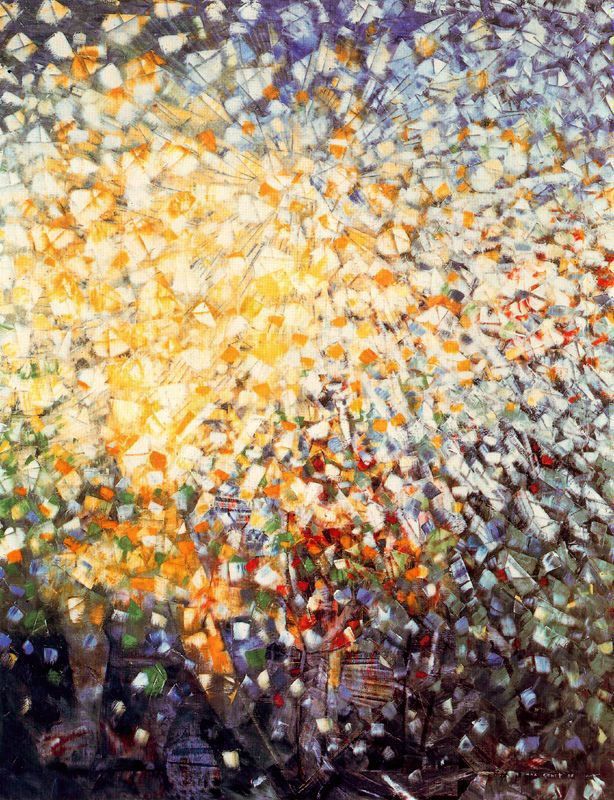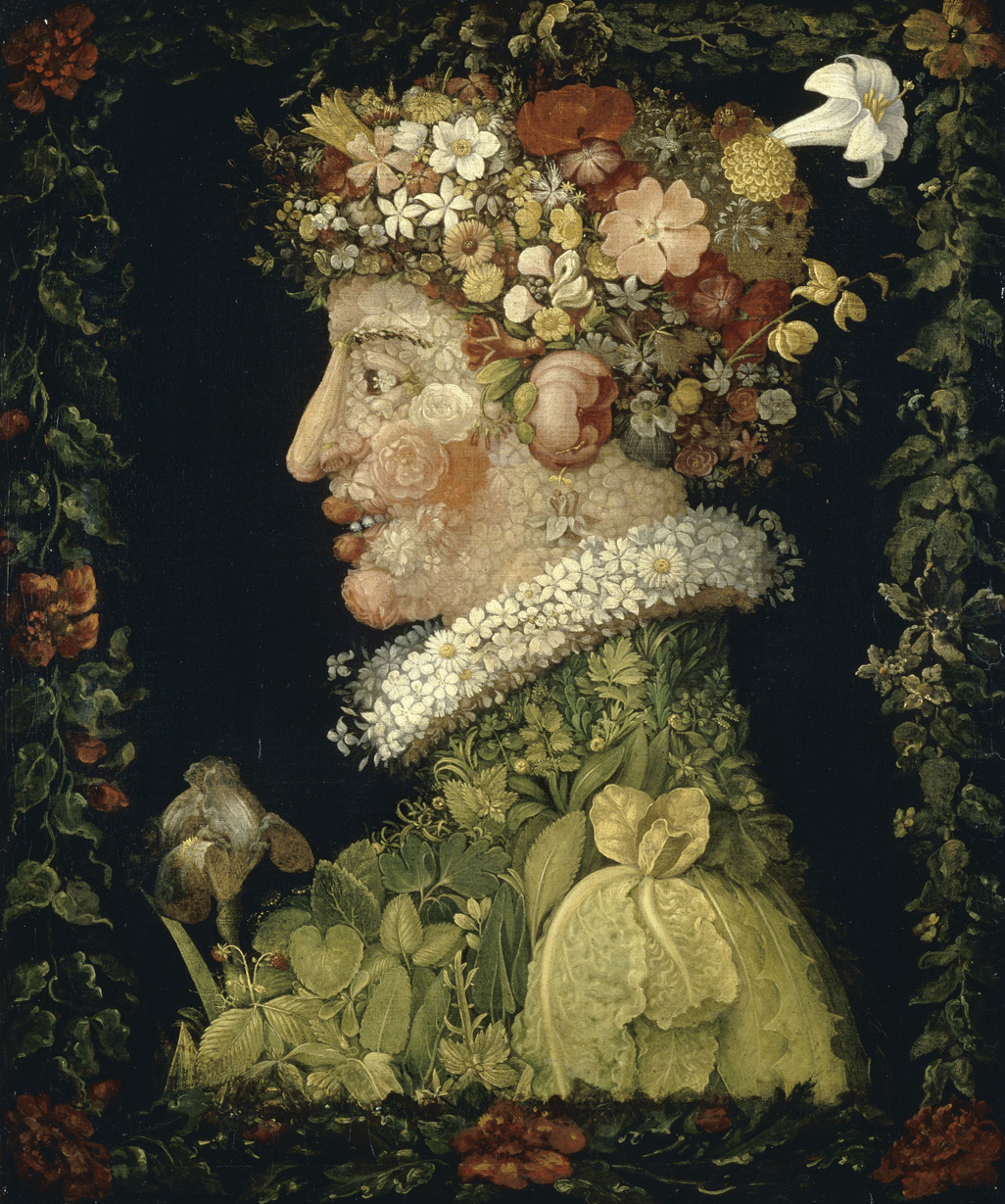User:Δεριζαματζορπρομπλεμιναυστραλια/Graduatreadings/ecolist: Difference between revisions
(Created page with " 222px|framed|right|Ernst: 33Girls Chasing White Butterflies 1 source--> [http://www.spiegel.de/international/zeitgeist/spiegel-i...") |
No edit summary |
||
| Line 26: | Line 26: | ||
Eco draws a distinction between "practical" lists and "poetic" lists. | Eco draws a distinction between "practical" lists and "poetic" lists. | ||
But it is '''Giuseppe Arcimboldo's Spring of 1573''' that most strongly evokes not just the visualization of a list but the core predicament of the enterprise. Arcimboldo painted a series of portraits using fruits, vegetables, and flowers as anatomical elements. In the case of Spring, he musters a veritable encyclopedia of flora to fill out and color the face and upper body of an aristocratic young woman. Her head is a compendium of flowers—their names and lore, their very stems and petals. Truly blooming and buzzing, she looks more than a little perplexed. The lady is in need of pen and paper so she can begin to make sense of herself: daisies, nightshades, daffodils, thyme, anemones, azaleas, irises, bloodroot, cornflowers, et cetera. She's in need of a list. To make order. To understand what's on her mind. | |||
[[File:Giuseppe Arcimboldo - Spring, 1573.jpg|222px|framed|right|Ernst: 33Girls Chasing White Butterflies]] | |||
Revision as of 14:49, 29 November 2014
1 source--> eco interview
The list is the origin of culture. It's part of the history of art and literature. What does culture want? To make infinity comprehensible. It also wants to create order -- not always, but often. And how, as a human being, does one face infinity? How does one attempt to grasp the incomprehensible? Through lists, through catalogs, through collections in museums and through encyclopedias and dictionaries. There is an allure to enumerating how many women Don Giovanni slept with: It was 2,063, at least according to Mozart's librettist, Lorenzo da Ponte. We also have completely practical lists -- the shopping list, the will, the menu -- that are also cultural achievements in their own right.
The list doesn't destroy culture; it creates it. Wherever you look in cultural history, you will find lists.
In "Ulysses," James Joyce describes how his protagonist, Leopold Bloom, opens his drawers and all the things he finds in them. I see this as a literary list, and it says a lot about Bloom. Or take Homer, for example. In the "Iliad," he tries to convey an impression of the size of the Greek army. At first he uses similes: "As when some great forest fire is raging upon a mountain top and its light is seen afar, even so, as they marched, the gleam of their armour flashed up into the firmament of heaven." But he isn't satisfied. He cannot find the right metaphor, and so he begs the muses to help him. Then he hits upon the idea of naming many, many generals and their ships.
At first, we think that a list is primitive and typical of very early cultures, which had no exact concept of the universe and were therefore limited to listing the characteristics they could name. But, in cultural history, the list has prevailed over and over again. It is by no means merely an expression of primitive cultures. A very clear image of the universe existed in the Middle Ages, and there were lists. A new worldview based on astronomy predominated in the Renaissance and the Baroque era. And there were lists. And the list is certainly prevalent in the postmodern age. It has an irresistible magic.
We like lists because we don't want to die.
2 source-->Mary Beard on Eco
Homer's "Catalogue" and of a vast range of other lists in western culture
Homer offered us two ways of seeing the world. On the one hand, there is that open-ended list of military forces, with all its indeterminacy and hints at infinity. On the other, later in the Iliad, there is a description of the magnificent shield, which the god Hephaestus made for Achilles, with the whole of the cosmos (from the stars in the sky to the sheep in the fields) represented within its frame. This is "finite form", a closed and bounded world, with nothing outside it and no possibility of addition or accretion. Eco leave us in no doubt which style of representation he prefers: the boundless list.
Ravel's Bolero
But throughout the book one particular worry nags at Eco's enthusiasm for the sheer profusion of meaning and the uncontrollable excess, which he sees as the defining feature of the list as a genre. For lists, as he admits, can also act to order, control and exclude. In fact, among students of literacy, the list is often seen as one of the main by-products of the invention of writing – and with lists come not so much an infinity of possibilities, but rule and orthodoxy. It is, for example, only when a culture can list its kings that it can enshrine a fixed view of its own history. A list of cities, territories or rivers, which Eco can find "dizzying" in James Joyce, is also one of the foundations of imperial control.
Eco draws a distinction between "practical" lists and "poetic" lists.
But it is Giuseppe Arcimboldo's Spring of 1573 that most strongly evokes not just the visualization of a list but the core predicament of the enterprise. Arcimboldo painted a series of portraits using fruits, vegetables, and flowers as anatomical elements. In the case of Spring, he musters a veritable encyclopedia of flora to fill out and color the face and upper body of an aristocratic young woman. Her head is a compendium of flowers—their names and lore, their very stems and petals. Truly blooming and buzzing, she looks more than a little perplexed. The lady is in need of pen and paper so she can begin to make sense of herself: daisies, nightshades, daffodils, thyme, anemones, azaleas, irises, bloodroot, cornflowers, et cetera. She's in need of a list. To make order. To understand what's on her mind.


